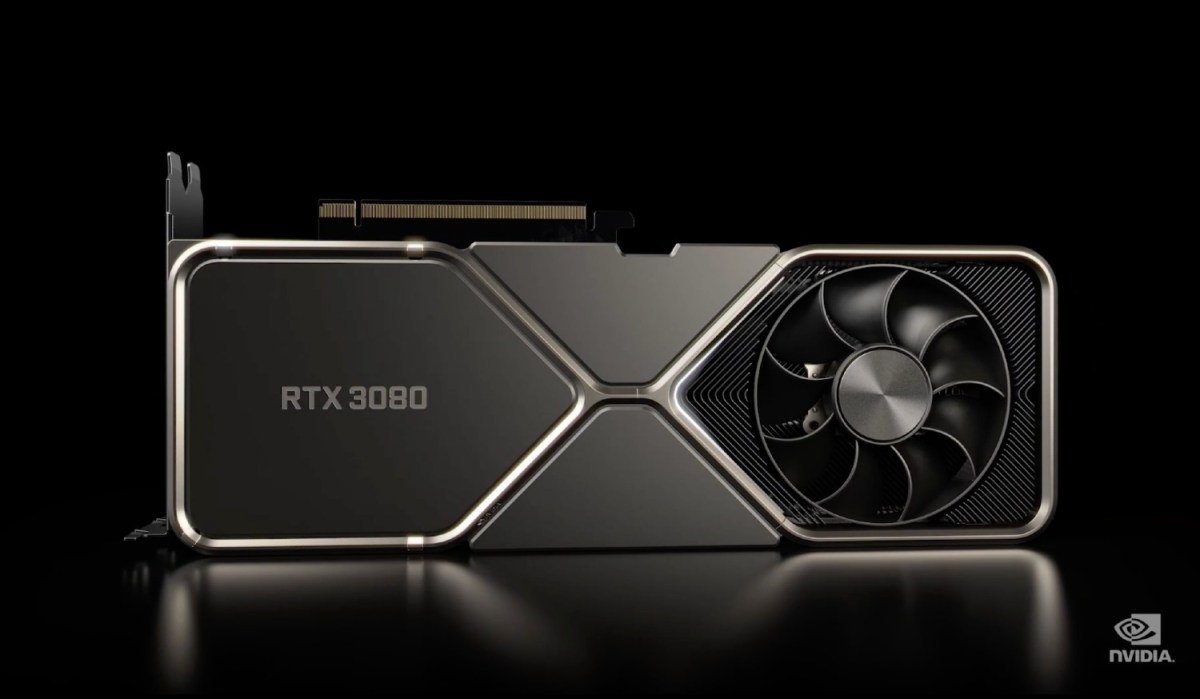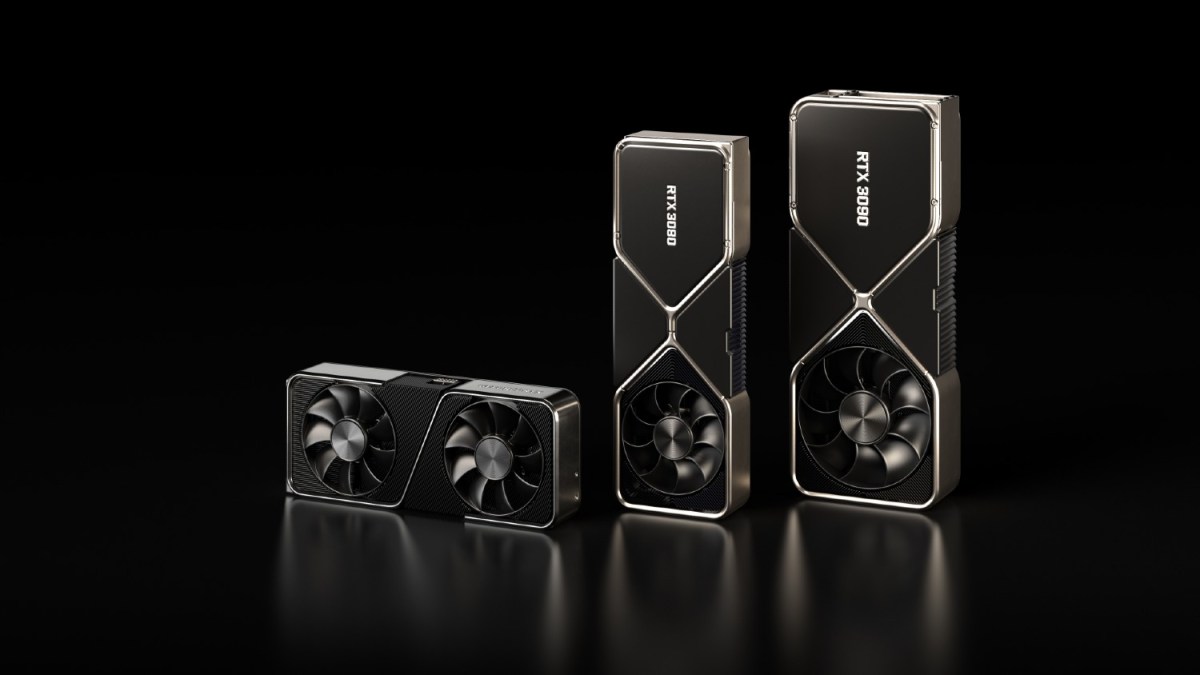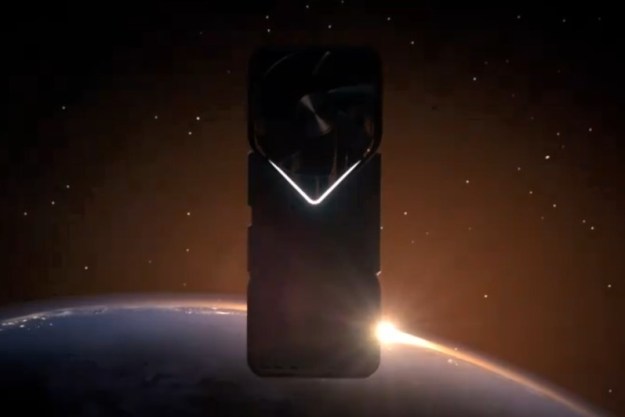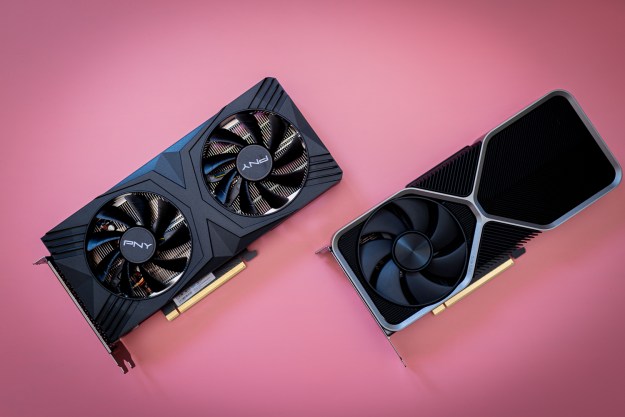The Nvidia GeForce RTX 3000 range brings some much-needed updates to the RTX lineup. These new cards sport the Ampere architecture, which is built on Samsung’s 8nm process. This new generation is different, though, delivering performance increases that Nvidia hasn’t seen in many years.
To help you navigate the range — and hopefully the GPU shortage — we rounded up everything you need to know about every Ampere card. The RTX 3080 is the flagship card, followed by the RTX 3070 and RTX 3060. There’s also the powerful RTX 3090 for workstation purposes and Ti variants of the rest of the range.
Release date and price
The RTX 3080 was announced on September 1, 2020, and it began shipping shortly after, on September 17.
Nvidia launched the card for $699, which is the same price as the RTX 2080 and 2080 Super. The larger and more powerful card of the generation, the RTX 3090, costs $1,500. The 3090, in some sense, replaces both the RTX 2080 Ti and RTX Titan. It’s sold in prebuilt gaming PCs, though it features 24GB of GDDR6X memory for workstation performance in fields like data science and media production.
Moving down the range, the RTX 3070 replaces the 2070 Super and costs $499. It was released shortly after the RTX 3080 and 3090 in October 2020. The “sweet spot” GPU, the RTX 3060 Ti, was released shortly after in December for $399.
Nvidia announced the RTX 3060 during its CES 2021 press conference, replacing the RTX 2060 and 2060 Super. It has an MSRP of $329 and launched in February 2021.
Finally, Nvidia revealed the RTX 3080 Ti and 3070 Ti during its Computex 2021 keynote. The RTX 3080 Ti launched on June 3 for $1,199, and the the 3070 Ti came a week later on June 10 for $599.
Design

The RTX 3080 Founders Edition features a new “unibody” design that’s a bit more modest compared to the reflective aluminum of the RTX 2000-series cards. We found the card to be quite classy in our review, with an angular design that features a matte, dark grey finish with white backlighting instead of the traditional green hue used on prior GeForce cards.
Early leaked images revealed a very industrial-looking card with a dual-fan design, and they turned out to be accurate. Marking a stark departure from older
The RTX 3090 uses this same design, only it’s much larger, as the card utilizes a triple-slot format. The RTX 3070, meanwhile, uses a more traditional dual-fan system. For a size comparison, check out the photo below. The RTX 3080 Ti and RTX 3070 Ti both use the dual axial design as the more expensive cards in the range.
The RTX 3060 Ti uses a similar design as the RTX 3070, with dual fans on the front for the Founder’s Edition, as does the RTX 3060.

The rumor mill has been spinning over a new 12-pin PCIe power interface system for some of these new cards, and the RTX 3080 and RTX 3090 will make use of the low-profile connectors. The company stated that the new connector combines the power of dual eight-pin connectors in a space-saving design. The RTX 3070, meanwhile, uses just a single eight-pin connector, as does the RTX 3060 Ti. The RTX 3080 Ti and RTX 3070 Ti utilize the 12-pin connector, which you can split off into an eight-plus-eight-pin connector.
Port selection includes three
Specs
Nvidia made some ambitious claims about its new RTX 3000-series cards, and they turned out to be true. First off, it said that both the RTX 3080 and RTX 3070 are more powerful than the current RTX 2080 Ti. As you can see from the chart below, it’s not hard to see how that’s true.
| CUDA cores | Memory | Memory interface | Boost clock | Graphics card power | |
| RTX 3090 | 10496 | 24GB GDDR6X | 384-bit | 1.70GHz | 350W |
| RTX 3080 Ti | 10240 | 12GB GDDR6X | 384-bit | 1.67GHz | 320W |
| RTX 3080 | 8704 | 10GB GDDR6X | 320-bit | 1.71GHz | 320W |
| RTX 3070 Ti | 6144 | 8GB GDDR6X | 256-bit | 1.77GHz | 290W |
| RTX 3070 | 5888 | 8GB GDDR6 | 256-bit | 1.73GHz | 220W |
| RTX 3060 Ti | 4864 | 8GB GDDR6 | 256-bit | 1.67GHz | 200W |
| RTX 3060 | 3584 | 12GB GDDR6 | 192-bit | 1.78GHz | 170W |
| RTX 2080 Ti | 4352 | 11GB GDDR6 | 352-bit | 1.54GHz | 250W |
| RTX 2080 Super | 3072 | 8GB GDDR6 | 256-bit | 1.82GHz | 250W |
| RTX 2070 Super | 2560 | 8GB DRR6 | 256-bit | 1.77GHz | 215W |
The RTX 3080 features 8,704 CUDA cores, making for a 65% leap over the RTX 2080 Super and a 50% increase over the RTX 2080 Ti. It’s also a more power-hungry card rated at 320 watts versus the standard 250 watts of the RTX 2080 Ti and RTX 2080 Super.
The RTX 3080 also features 10GB of GDDR6X memory at 19Gbps, which is as fast as it gets. Nvidia said it had collaborated with Micron for the G6X video
Nvidia is also bundling in its new RTX I/O to help improve game loading times on its GPUs. There are three components in play here for the new RTX I/O, including new APIs for fast loading and streaming directly from SSD to GPU memory, GPU lossless decompression, and collaboration with Microsoft for direct storage for Windows.
The result of all this, Nvidia claims, is twice the performance of the original RTX 2080. In real-life performance, the RTX 3080 can consistently run games at 60 fps (frames per second) in
Even bigger claims were made about the RTX 3090, which can reportedly play games in 8K at 60 fps. Although that’s a little far, the RTX 3090 is still a monster of a card. This is done using DLSS 2.0, of course, rather than native rendering. The RTX 3070, meanwhile, is supposedly 1.6 times faster than the RTX 2070.
Moving into the mid-range, Nvidia has two offerings: The RTX 3060 Ti and RTX 3060. The 3060 Ti has already proven itself as the sweet spot for price and performance, with an MSRP of only $400. It’s a remarkable card at that price, delivering performance similar to the last-gen RTX 2080 Ti (a $1,200 GPU) in most games.
The RTX 3060’s specs are, for the most part, what we’ve come to expect from Nvidia’s RTX 3000 range. The exception is the 12GB of GDDR6 memory, surpassing the RTX 3060 Ti, 3070, and even 3080.
We have some general performance specs, too: 13 shader TFLOPs, 25
The RTX 3080 Ti and RTX 3070 Ti update the higher-end cards in the range. The RTX 3080 Ti mirrors the RTX 3090 in most specs, utilizing nearly as many CUDA, Tensor, and RT cores. The difference is that it comes with half of the GDDR6X memory, making it a great card for gaming but a weaker choice for data science and 3D modeling.
The RTX 3070 Ti is more of a marginal upgrade. It comes with 256 more CUDA cores and a slightly boosted clock compared to the base 3070. The big upgrade is 8GB of G6X memory, which is able to deliver much higher bandwidth on the same 256-bit bus.
Performance

The new cards are all built on the new Ampere microarchitecture, which is based on Samsung’s 8nm processor, featuring 28 billion transistors. Ampere uses second-generation RT cores and third-generation Tensor cores to boost performance.
In our RTX 3080 review, we found the performance of the card to be quite impressive. In our 3DMark Time Spy test, the performance of the RTX 3090 was 15% better than the RTX 2080 Ti, despite the latter costing $500 more than Nvidia’s newest offering, and 28% better than the RTX 2080.
We found that the RTX 3080 delivered solid performance uplift compared to the RTX 2080, but the gains weren’t quite as high as what Nvidia claimed. In Assassin’s Creed Odyssey, we found that the RTX 3080 was able to hit 61 fps on the game on native
While the generational improvement in performance was expected for a new GPU family, the new Ampere cards perform significantly better at ray tracing, the hallmark feature of the RTX family and an area of struggle for the RTX 2000 series. Ampere’s improvements with artificial intelligence and DLSS improve
In our test of the RTX 3080 on Battlefield V, we found
Still, there were some performance bottlenecks when
Bringing in the other cards, you can expect around a 20% difference in performance for each step down. The RTX 3070 performs about 80% as well as the RTX 3080, and so on. The Ti models complicate things a bit, though.
The RTX 3080 Ti is a significant upgrade over the RTX 3080 on paper, but it only represents around a 10% improvement in practice. In our RTX 3080 Ti review, we found a 9% improvement in 3DMark Time Spy scores compared to the RTX 3080, and it earned around five extra frames per second in Assassin’s Creed Valhalla and Battlefield V.
We noted a similar performance increase in our RTX 3070 Ti review. We measured an 8% improvement across synthetic and real-world benchmarks, mirroring the RTX 3080 Ti (though without the price premium). That said, the RTX 3070 Ti isn’t an RTX 3080 killer. It’s more of a 1440p card than a
Editors' Recommendations
- Intel Battlemage graphics cards: release date speculation, price, specs, and more
- Everything you need to know about buying a GPU in 2024
- The Nvidia RTX 4080 Super just trounced AMD
- Here’s how AMD counters Nvidia’s big RTX Super launch
- RTX 4080 Super vs. RTX 4070 Ti Super vs. RTX 4070 Super: Nvidia’s new GPUs, compared


